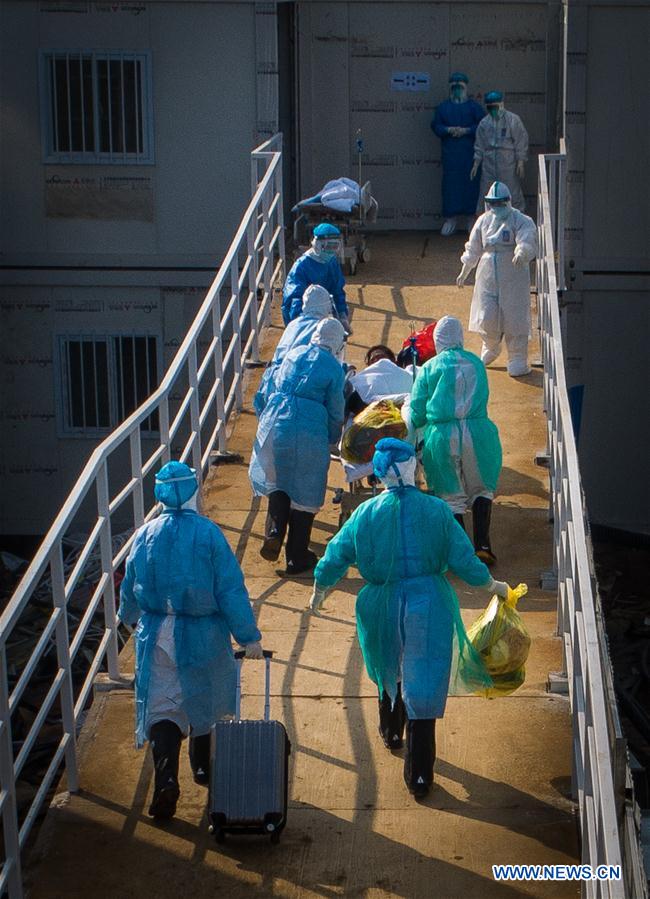

A 1,000-bed hospital in Wuhan, the epicenter of the novel strain of coronavirus outbreak in central China's Hubei Province, was finished and delivered to the People's Liberation Army on Feb. 2.

Aerial photo taken on Feb. 4, 2020 shows medical workers helping the first batch of patients infected with the novel coronavirus move into their isolation wards at Huoshenshan (Fire God Mountain) Hospital in Wuhan, central China's Hubei Province. (Xinhua/Xiao Yijiu)
The new Huoshenshan (Fire God Mountain) Hospital, which was built to receive highly contagious pneumonia patients, with a total construction area of nearly 33,900 square meters, was completed in less than 10 days after construction began.
During the peak period, there were more than 800 management personnel, more than 4,000 workers, nearly 1,000 large pieces of mechanical equipment and vehicles on the construction site of Huoshenshan Hospital.
The well-equipped facilities of the hospital would ease the shortage of medical beds in the city resulting from an increasing number of patients infected by the novel coronavirus.
In order to promote the Huoshenshan Hospital project in a high-quality and efficient way, young building workers came and participated in the construction work from all parts of the country, according to Zhou Kai, head of the youth league committee of China Construction Third Engineering Bureau Co., Ltd.
Zhou added that young people are the main force in the fight against the outbreak, as the proportion of them is above 60 percent among the total builders.
Huoshenshan Hospital is a replication of Xiaotangshan Hospital, a temporary medical center in the northern suburb of Beijing built in 2003. Beijing built Xiaotangshan Hospital in just a week for the treatment and control of SARS, or Severe Acute Respiratory Syndrome.
At the time of the family reunion during China’s Spring Festival, thousands of building workers from all parts of the country were pooled together in Wuhan.
In the early morning of Jan. 23, brothers Liu Xing and Liu Fei immediately volunteered to participate in the construction when they learned of the construction task. Their wives also rushed back to Wuhan from their hometown overnight and worked together with their husbands at the construction site.
On the afternoon of Jan. 23, Wei Hui, who was shopping with his wife in the supermarket, received a call from the manager. As an employee in the overhaul and construction area of the power supply company of Caidian District, Wuhan, he had a premonition of the emergency.
He left a truckload of unchecked New Year goods and disappeared from his wife's sight and rushed to the construction site of the Huoshenshan Hospital on the same day.
"We must contribute to the construction of the Huoshenshan Hospital! " That night, Wei Hui and his colleagues dismantled the main supply line within two hours, ensured the entry of large machinery and equipment, and completed the relocation and renovation of a 10 kV line overnight.
At 9 p.m. of February 1, the construction site of Huoshenshan Hospital was in full heat, as the workers of the China Construction Third Engineering Bureau Co., Ltd. were burning the midnight oil.
The construction workers on the site were busy for 24 hours without sleep, so as to deliver the project as scheduled on Feb. 2 on time.
Shortly after holding a wedding with his wife in his hometown, Huang Tian rushed back to Wuhan.
The drawings of Hongshenshan Hospital must be finished in one time efficiently, which was a daunting challenge for Huang, a technician of the China Construction Third Engineering Bureau Co., Ltd., and his colleagues.
At 1 a,m. on Jan. 31, the construction site of Huoshenshan Hospital was brightly lit. This day is the birthday of Huang’s new wife, however, Huang was too busy to remember the day.
Two days earlier, Huang had spent his 29th birthday designing throughout the night. "I believe the Huoshenshan Hospital will be completed as soon as possible, and Wuhan will return to its former prosperity," Huang said.

 Award-winning photos show poverty reduction achievements in NE China's Jilin province
Award-winning photos show poverty reduction achievements in NE China's Jilin province People dance to greet advent of New Year in Ameiqituo Town, Guizhou
People dance to greet advent of New Year in Ameiqituo Town, Guizhou Fire brigade in Shanghai holds group wedding
Fire brigade in Shanghai holds group wedding Tourists enjoy ice sculptures in Datan Town, north China
Tourists enjoy ice sculptures in Datan Town, north China Sunset scenery of Dayan Pagoda in Xi'an
Sunset scenery of Dayan Pagoda in Xi'an Tourists have fun at scenic spot in Nanlong Town, NW China
Tourists have fun at scenic spot in Nanlong Town, NW China Harbin attracts tourists by making best use of ice in winter
Harbin attracts tourists by making best use of ice in winter In pics: FIS Alpine Ski Women's World Cup Slalom
In pics: FIS Alpine Ski Women's World Cup Slalom Black-necked cranes rest at reservoir in Lhunzhub County, Lhasa
Black-necked cranes rest at reservoir in Lhunzhub County, Lhasa China's FAST telescope will be available to foreign scientists in April
China's FAST telescope will be available to foreign scientists in April